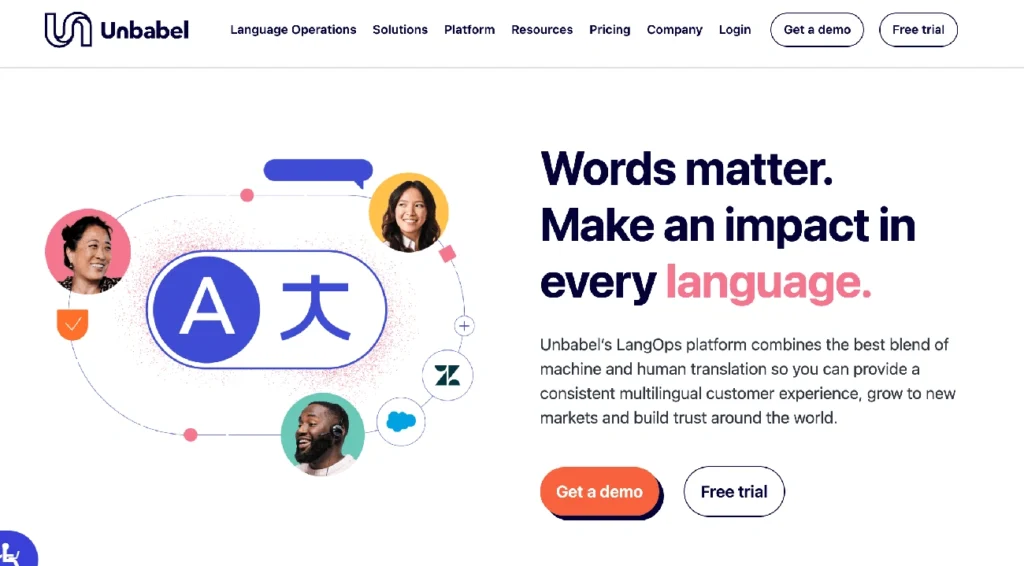AI translator tools have evolved significantly beyond simple word-for-word conversions. The days of struggling with awkward translations that miss context and nuance are over.
Modern AI translation software delivers more accurate results with better contextual understanding. These tools quickly eliminate language barriers for document translation, support chats, and international meetings. The Currents 2023 report reveals that 26% of organizations already use AI to improve operations.
AI translation tools in 2025 offer much more than the old copy-paste approach to Google Translate. Smart, secure platforms now preserve formatting, manage terminology, and enable seamless collaboration. These AI translation services deliver faster, more cost-effective global communication while protecting language integrity.
We tested the market’s leading options to bring you this piece on the 17 best AI translators that deserve your investment in 2025.
1. DeepL

Image Source: DeepL Translate
DeepL leads the AI translator market, with 82% of language service companies choosing its technology. The company outperformed tech giants like Google and AWS in 2024, growing its market share by 44% to become the leading machine translation provider.
DeepL key features
DeepL stands out from competitors with these powerful AI translation capabilities:
- Superior accuracy: Language experts found in blind tests that DeepL translations were 1.3x more accurate than Google and 2.3x more accurate than Microsoft.
- Document translation: The system handles PDFs, Word documents, and PowerPoint presentations while keeping their original formatting.
- Glossary feature: You can create and manage customized terminology lists that ensure consistent translations of your brand terms.
- Image translation: The tool translates text from images, including signs, screenshots, and menus.
- Formal/informal tone selection: You can adjust translations to match your needed level of formality.
DeepL pros and cons
Pros:
- Highly accurate translations, particularly for European languages
- Easy-to-use interface with simple options
- Enterprise-grade security backed by ISO 27001, SOC 2, GDPR, and HIPAA compliance
- Document translations that maintain formatting
- Glossaries let you customize specialized terminology
Cons:
- Fewer language options than competitors, with a focus on European languages
- Customization options are limited beyond glossaries
- Translation memory features aren’t available
- Technical content placeholders sometimes get lost
DeepL pricing
DeepL’s pricing structure includes:
- Free version: You get 500,000 characters monthly
- Paid plans: Unlimited text translations start at $8.99 monthly
- API Pro plan: Developers and businesses can integrate the service
Enterprise customers receive customized solutions with security features and centralized management.
DeepL best use cases
DeepL shines in these scenarios:
- Business communication: Global companies save 90% on translation time and see 345% ROI
- Document translation: Business documents stay formatted while getting secure translations
- Cross-language team collaboration: Teams speaking different languages work better together, as shown by Spindox’s Italian-Chinese teams
- E-commerce expansion: Businesses enter new markets quickly by translating product listings and reviews
- Standardizing global communication: Deutsche Bahn uses the platform to standardize communication for over 320,000 employees across 16 languages
2. Google Translate
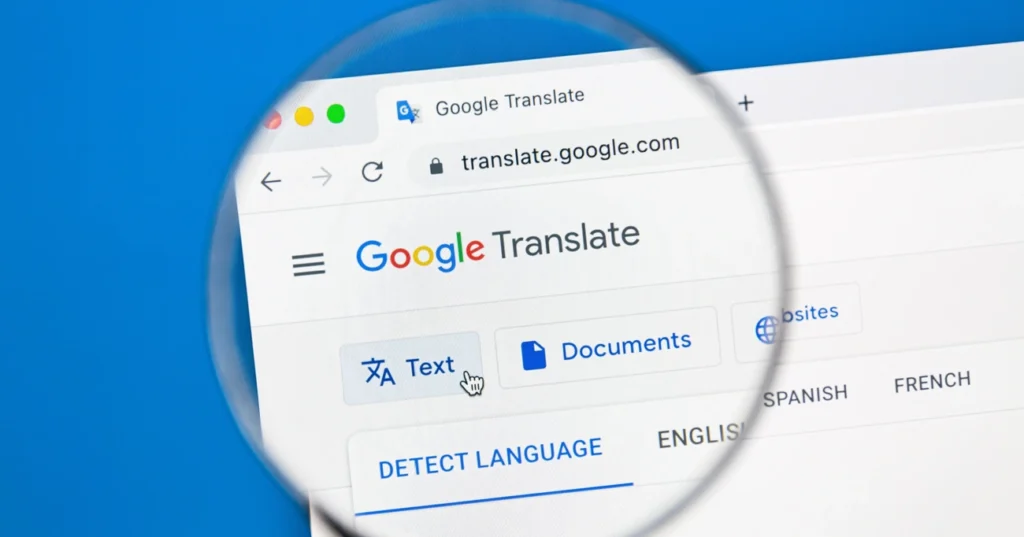
Image Source: Search Engine Journal
2. Google Translate
Google Translate handles a staggering 1 trillion words monthly through its services. This tool has grown way beyond its initial scope to become one of the most available AI translators today.
Google Translate key features
Google Translate utilizes advanced AI capabilities from Gemini models to offer detailed translation services:
- Live conversation translation: Enables two-way conversations in over 70 languages including Arabic, French, Hindi, Korean, Spanish, and Tamil
- Noise-resistant technology: Works well in busy spots like airports or cafes with specialized voice recognition models
- Language practice tool: Offers custom scenarios to help you learn new languages through interactive exercises that match your level
- Visual translation: Works with Google Lens and Circle to Search when you need to translate text from images
- Document translation: Keeps formatting intact while translating different types of documents
Google Translate pros and cons
Pros:
- Impressive coverage with over 130 languages
- Strong accuracy for common language pairs (up to 94% for Spanish)
- Basic version comes free for everyone
- Blends smoothly with browsers and mobile devices
- Smart noise filtering gives clear translations even in crowded places
Cons:
- Accuracy changes substantially by language (55% for Armenian to 94% for Spanish)
- Medical, legal, or creative content needs different solutions
- Doesn’t deal very well with context nuances and cultural expressions
- Misses irony and research capabilities that human translators offer
- Asian languages prove tricky (except Japanese)
Google Translate pricing
- Basic service: Free with no limits on text translations
- Cloud Translation API:
- First 500,000 characters monthly: Free
- 500,000 to 1 billion characters: $20 per million characters
- Document translation: $0.08 per page
- Advanced options like Adaptive Translation: $25 per million characters
Google Translate best use cases
Google Translate shines in these situations:
- Everyday travel communication: Quick help when you’re in foreign countries
- Real-time conversations: Perfect for on-the-spot interactions with live translation
- Language learning: Practice feature builds your skills through personalized scenarios
- Basic website translation: Quick understanding of web content
- Casual content: Great for social media posts, comments, and informal messages
Professional content that needs precision and nuance might need alternative solutions or professional translators.
3. ChatGPT
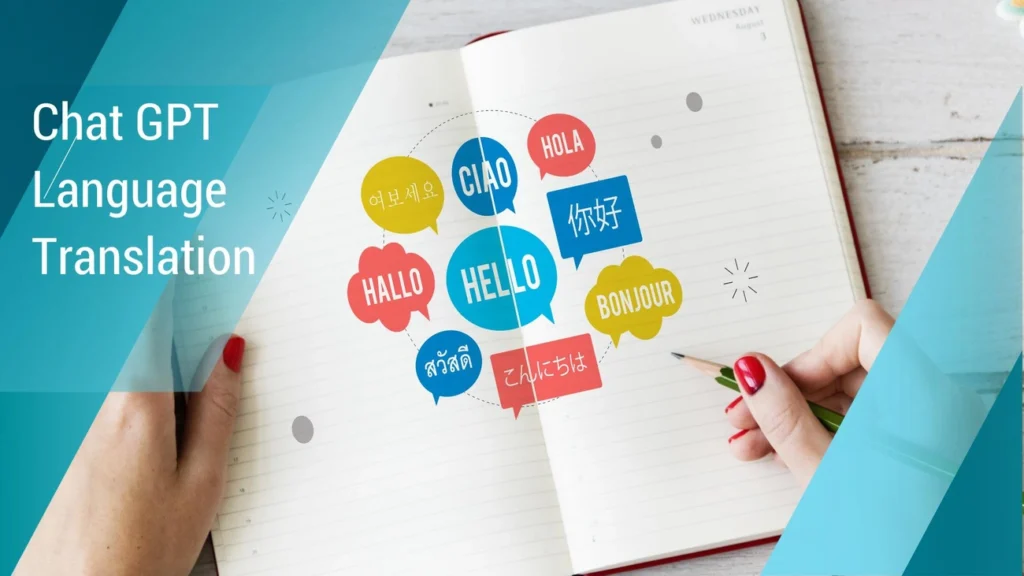
Image Source: Wondershare EdrawMax
3. ChatGPT
ChatGPT stands out as a powerful AI translator that understands context beyond simple word-for-word conversions. OpenAI’s large language model delivers translation capabilities that continue to evolve faster than ever.
ChatGPT key features
- Multilingual support for over 80 languages with varying proficiency levels
- Advanced Voice Mode enables live speech-to-speech translation with preserved intonation
- Contextual awareness maintains narrative consistency across languages
- Multimodal capabilities allow image text translation and conversation memory
- Live conversation translation continues until you request it to stop
ChatGPT pros and cons
Pros:
- Masters understanding of idioms and colloquialisms like “blow off steam”
- Reaches 88.7% accuracy on language understanding measures
- Maintains consistent tone across translations
- Provides explanations with translations to enhance context
Cons:
- Translation quality varies substantially by language pair
- Human review becomes necessary for technical, legal, or medical content
- Occasional hallucinations result in collateral damage like sounds or gibberish
- Users have limited control over translation quality
ChatGPT pricing
- Free version (GPT-3.5): Simple translation capabilities with limitations
- ChatGPT Plus ($20/month): Access to GPT-4, which performs better for translation
- API pricing: Varies by model, ranging from $0.05-$1.25 per million input tokens
- Batch API: Users save 50% on inputs/outputs for asynchronous tasks
ChatGPT best use cases
ChatGPT proves excellent as an AI translation tool for:
- Internal communications and draft translations
- Creative content that preserves tone and style
- Context-sensitive material where cultural nuance matters
- Live multilingual conversations through Advanced Voice Mode
- Original content creation before professional review
Specialized translation tools like DeepL remain superior for formal business language and European languages.
4. Lokalise AI
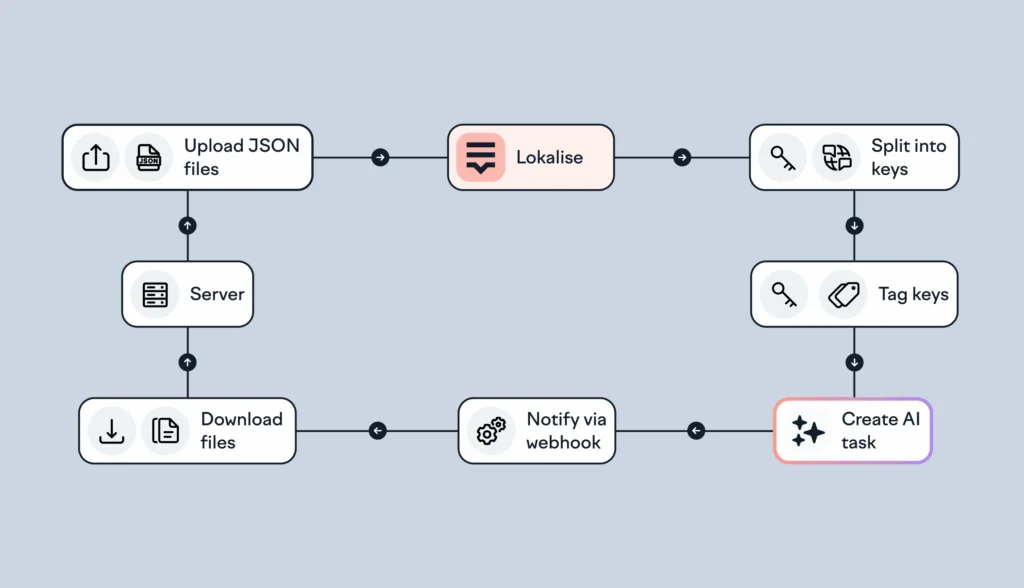
Image Source: Lokalise
4. Lokalise AI
Lokalise AI is a powerful AI translator that works as part of a complete translation management system (TMS). The platform goes beyond basic translation tools by combining AI-powered translation with full localization workflow management.
Lokalise AI key features
- Human-like accuracy: The system delivers translations with approximately 80% accuracy on first attempt
- Multi-engine technology: The platform reviews multiple translation engines including GPT-4o, Claude Sonnet 3.5, DeepL, Google Translate, and Microsoft Translate
- Style guide integration: Your customized style guides and glossaries help maintain brand consistency
- Bulk translation: The system handles content translation to over 30 languages at once
- AI quality assurance: The Dynamic Quality Framework identifies linguistic issues automatically
- One-click optimization: You can shorten, rephrase, and optimize translations for SEO
Lokalise AI pros and cons
Pros:
- Translation speed is 10x faster than traditional methods
- Translation costs drop by up to 80%
- The platform blends with 55+ platforms including GitHub, Figma, and popular CMS tools
- Brand voice stays consistent across languages
- Translations adapt to specific industries and content types
Cons:
- AI features need TMS subscription
- OpenAI models power most functions
- Short text strings work better than long-form content
- Accuracy varies based on language pairs and content complexity
Lokalise AI pricing
The Essential plan starts at USD 120 per month. Word translation begins at USD 0.01 per word, and volume discounts are available. Enterprise customers who process 1 million words yearly typically pay between USD 70,000-80,000 with a 50-user Enterprise plan bundle.
Lokalise AI best use cases
Lokalise AI works best for:
- Quick multi-language product launches (a customer launched 7 languages with 100,000+ words per language)
- Automated translation workflows for content updates
- Brand consistency across global markets
- Development workflow integration through API and webhooks
- Quality translations at lower costs (a customer saved 70% on translation costs)
5. Microsoft Translator

Image Source: Microsoft
5. Microsoft Translator
Microsoft Translator stands out as a reliable AI translator that uses neural machine translation technology within the Azure AI services family. The cloud-based service helps users translate text and documents in more than 90 languages and dialects.
Microsoft Translator key features
- Neural machine translation technology delivers accurate translations through simple REST API calls
- Asynchronous batch translation maintains original document structure and formatting
- Customizable translation models adapt to industry-specific terminology and style
- On-device translation options work with 29+ languages without internet connection
- Dictionary and transliteration capabilities provide alternative translations and examples
Microsoft Translator pros and cons
Pros:
- Microsoft Office products and services work together smoothly
- Default no-trace security ensures translated content stays private
- Custom Translator interface lets users work with translation memory
- SSL encryption protects data transmission
- Cloud and container deployments offer flexibility
Cons:
- System needs regular updates to work properly
- API setup takes more effort than consumer alternatives
- Translation quality varies between language pairs
- Consumer options offer a more user-friendly experience
Microsoft Translator pricing
- Free tier (F0): 2 million characters monthly for standard translation
- Pay-as-you-go (S1): $10 per million characters for text translation
- Document translation: $15 per million characters
- Custom translation: $40 per million characters with $10 monthly model hosting fee
- Volume discounts come with commitment tiers
Microsoft Translator best use cases
Microsoft Translator works best for:
- Enterprise-level translation projects that need security compliance
- Document translation projects involving multiple languages
- Organizations already using Microsoft ecosystems
- Industries needing specialized terminology in translations
- Development teams that integrate translation through REST API
6. Amazon Translate
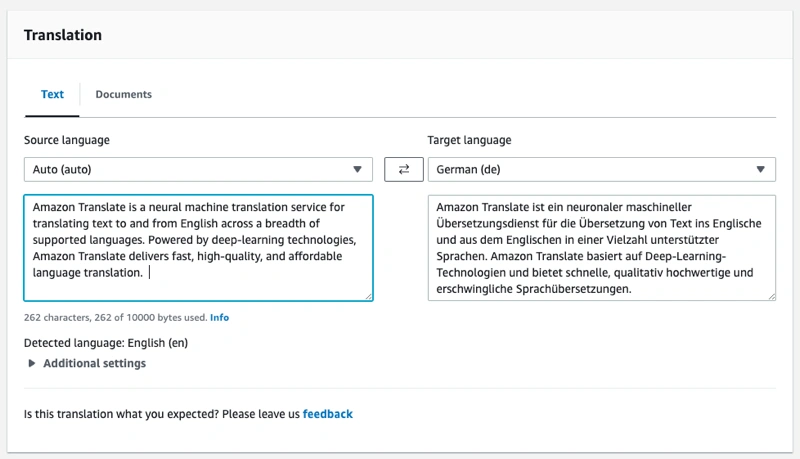
Image Source: AWS Documentation
6. Amazon Translate
Amazon Translate provides neural machine translation capabilities that handle text in 75 languages and 5,550 language pairs. This AI translator tool excels through its integration with the AWS ecosystem.
Amazon Translate key features
- Wide language support encompasses 75 languages including Afrikaans, Arabic, Hindi, Japanese, and Welsh
- Immediate and batch processing handles documents up to 5GB
- Document translation keeps original formatting for Text, HTML, DOCx, PPTx, and XLSx files
- Active Custom Translation lets you customize outputs with your parallel data
- Automatic language identification detects languages when codes are missing
Amazon Translate pros and cons
Pros:
- Smooth integration with other AWS services like Comprehend and Polly
- Enterprise-level translation needs scale easily
- Data transmission stays secure with SSL encryption
- Cost reduction through caching for repeated translations
Cons:
- Developer-oriented rather than user-friendly
- API implementation needs technical expertise
- Custom translations come at premium rates
- Not suitable for everyday users
Amazon Translate pricing
- Standard Text Translation: $15 per million characters
- Real-Time Document Translation (Text & HTML): $15 per million characters
- Real-Time Document Translation (Docx): $30 per million characters
- Active Custom Translation: $60 per million characters
- Free tier: 2 million characters monthly for 12 months
Amazon Translate best use cases
Amazon Translate shines when:
- Multilingual applications and websites need building
- Business documents require translation with preserved formatting
- Customer support needs cross-language capabilities
- Large multilingual content volumes need processing
- AWS ecosystems require globalized user experiences
7. Smartling
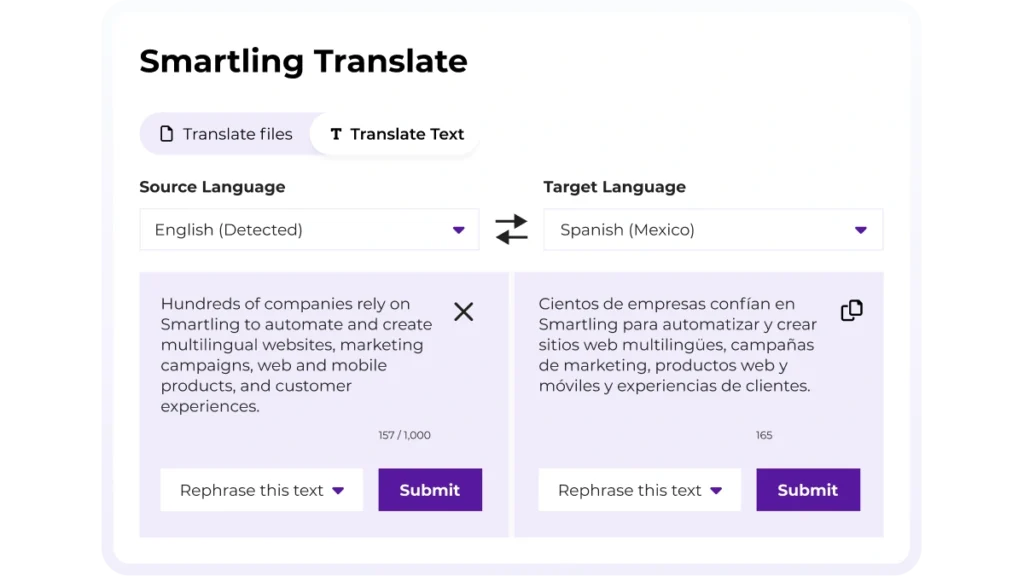
Image Source: Smartling
7. Smartling
Smartling goes beyond a simple AI translator tool. This cloud-based platform serves as a detailed translation management system (TMS). Your content systems connect directly with translation workflows to create simplified processes for global content creation.
Smartling key features
- Translation Management System shows all translations in one view with immediate progress updates
- Global Delivery Network automatically detects and replaces website text with approved translations
- Flexible integration options include APIs and pre-built connectors for WordPress, Contentful, and Adobe Experience Manager
- AI-powered translation options range from machine translation to human-edited content
- Visual context tools blend machine learning with integrated quality checks
Smartling pros and cons
Pros:
- Translation time drops from weeks to hours or minutes
- Translation costs decrease by up to 50% compared to traditional methods
- Users get unlimited access at no extra cost
- Teams collaborate easily with built-in communication features
- Quality assessment follows the Multidimensional Quality Metrics framework
Cons:
- Learning curve steeper than standalone translation tools
- Users need time to master all features
- Small projects might find enterprise features overwhelming
- Some workflow steps lack editing flexibility
Smartling pricing
- Core plan: Small teams and individuals can translate business documents
- Enterprise plan: Companies can scale their translation operations
- Translation services:
- Machine Translation: Starting at $0.01/word
- AI Translation: Starting at $0.06/word
- AI Human Translation: Starting at $0.12/word
- Human Translation: Starting at $0.20/word
Smartling best use cases
Businesses managing multilingual content on multiple platforms will find Smartling invaluable. The platform shines when companies need automated translation workflows with quality controls. Website localization becomes easier through Smartling’s Global Delivery Network. Teams using content management systems benefit from ready-to-use integrations.
8. Unbabel

Image Source: Unbabel
8. Unbabel
Unbabel combines AI translation with human editors to produce high-quality multilingual content at scale. Their hybrid approach lets businesses connect with customers worldwide without the need to hire native speakers for each language.
Unbabel key features
- Hybrid translation technology combines AI with human editors who ensure quality and update translation algorithms
- Quality Estimation system automatically checks translations and optimizes processes by using machine translation when appropriate
- Uninterrupted integrations with popular platforms like Zendesk, Salesforce, and Shopify
- Language Library and custom translation glossaries help you maintain your brand’s voice
- ISO 27001 certification with reliable data encryption and anonymization protects your data
Unbabel pros and cons
Pros:
- Cuts support costs while delivering quality translations
- Lets agents support customers in any language
- Shows complete transparency through quality, usage, and spend reports
- Keeps your brand’s voice and style consistent across languages
Cons:
- Costs more than pure machine translation options
- Needs integration setup with existing systems
- Suits enterprise-level operations better than individual users
- Benefits take time to reach their peak
Unbabel pricing
- Standard plan: Starts at $30,000 annually
- Enterprise plan: Starts at $120,000 annually
- Flexible pricing options with different translation pipelines (Machine, Hybrid, Premium) based on speed, quality, and cost needs
Unbabel best use cases
Unbabel excels especially when you have:
- Global customer support teams who need multilingual capabilities without language-specific hiring
- Businesses entering new markets that need to speed up go-to-market delivery by up to 65%
- Companies aiming to boost CSAT scores (one client achieved 22.5% improvement)
- Organizations wanting to cut average translation turnaround time by 20%
- Enterprises that need secure, compliant translation solutions
9. Wordly
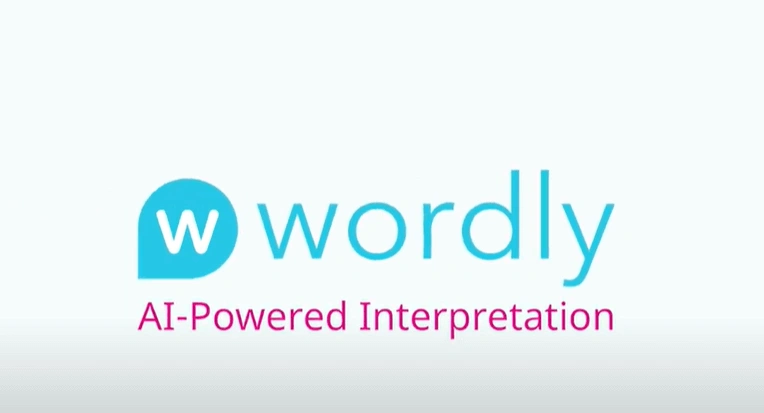
Image Source: Wordly.ai
9. Wordly
Wordly eliminates language barriers at live events through its specialized AI translation platform. The platform converts speaker presentations into audio and captions in dozens of languages at the same time.
Wordly key features
- Real-time translation for in-person, virtual, and hybrid events without human interpreters
- Multiple output formats like translated audio, subtitles, transcripts, and summaries
- Quick setup that organizers can complete in under 5 minutes
- Customizable glossaries that improve translation quality for industry-specific terms
- Platform integrations with Zoom, Cvent, and other event management tools
Wordly pros and cons
Pros:
- Attendees can use their own devices without special equipment
- The platform handles thousands of language pairs simultaneously
- Users don’t need to download anything or create accounts
- SOC 2 Type II compliant security meets enterprise standards
Cons:
- The system needs internet connection
- Human interpreters offer more nuanced translations than AI
- The platform works best with structured presentations rather than quick conversations
Wordly pricing
The platform uses usage-based pricing that starts with 10-hour packages. Available plans range from Starter to Enterprise (500-10,000 hours yearly). Non-profits and educational institutions get 10% off. Users can save about 50% compared to human interpreters.
Wordly best use cases
Wordly shines at industry conferences, corporate town halls, medical events, city council meetings, and religious services. Global sales teams find it valuable for their kickoff events. The platform helps organizations boost civic engagement and multilingual participation.
10. TranslatePress AI
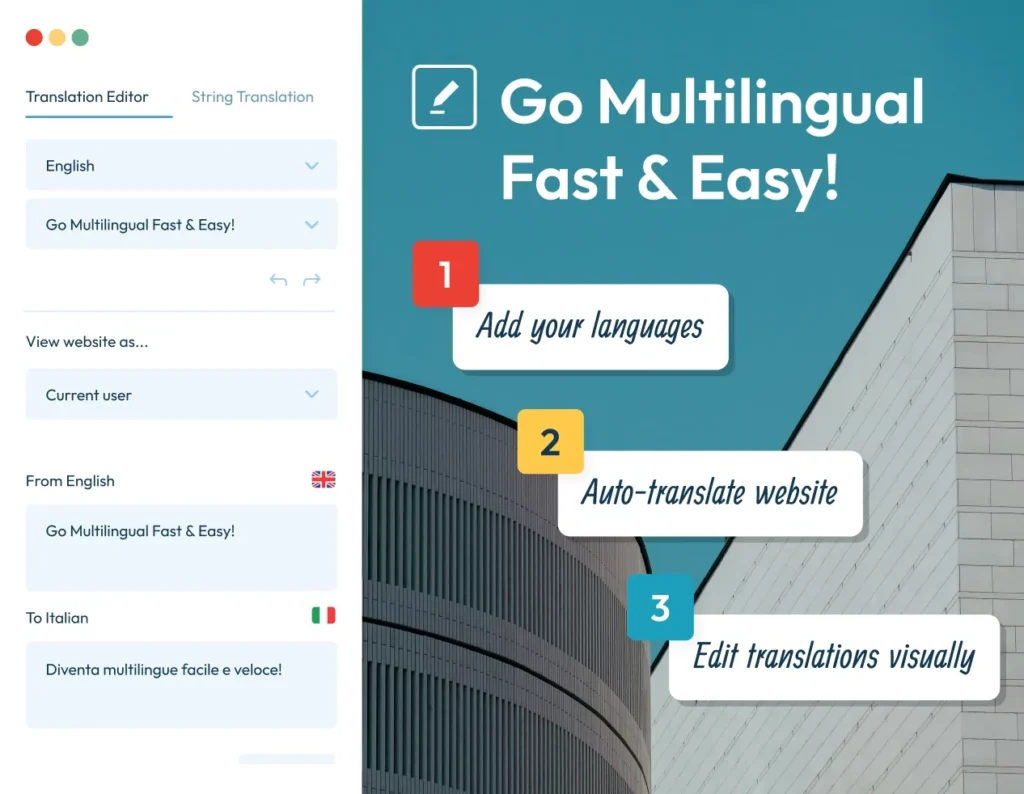
Image Source: translatepress.com
10. TranslatePress AI
TranslatePress AI is a straightforward solution that helps WordPress website owners create multilingual content. This AI translator works right inside your WordPress site without any complex setup needed.
TranslatePress AI key features
- Combined translation engines that use leading neural machine translation services to get the best accuracy
- Visual translation editor that lets you review and fix automated translations instantly
- Automatic detection of new content and changes, along with SEO metadata
- Multilingual SEO support for page slugs, titles, descriptions, and social graph information
- No API setup required – just add your license key and pick your target languages
TranslatePress AI pros and cons
Pros:
- Easy to use with WordPress themes, plugins, and page builders
- Works with WooCommerce for e-commerce translation
- Front-end translation interface shows live previews
- Detects language automatically based on browser settings
Cons:
- Works only with WordPress websites
- You need premium plans for multiple languages
- Word limits depend on your subscription level
- Better for websites than documents
TranslatePress AI pricing
Premium plans start at €99/year (Personal) and give you 50,000 AI translated words. The Business Plan costs €199/year with 200,000 words, while the Developer Plan at €349/year gives you 500,000 words. You can buy extra word packages: 100,000 words (€24), 200,000 words (€40), or 500,000 words (€90).
TranslatePress AI best use cases
This tool works best for WordPress websites that need multiple language versions. It’s great for WooCommerce stores and websites that update their content often and need quick translations.
11. Copy.ai
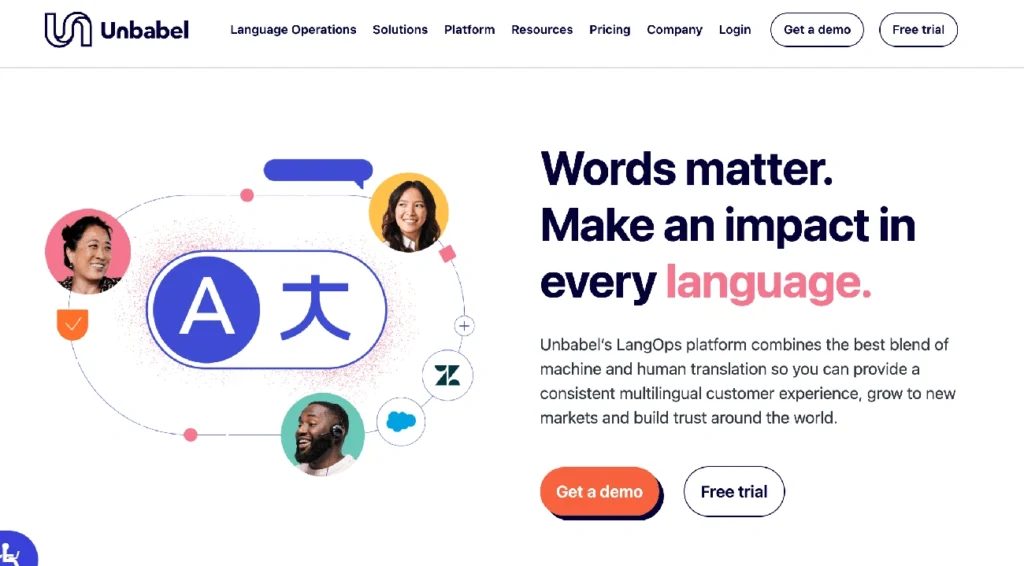
Image Source: Copy.ai
11. Copy.ai
Copy.ai serves as a versatile AI translator that blends with marketing workflows. This generative AI platform handles translation tasks through its advanced language models and supports over 30 languages.
Copy.ai key features
- Workflow automation that scales content translation without manual work
- Brand Voice feature to keep tone consistent across languages
- Localization capabilities to adapt marketing materials for regional markets
- Chat interface to handle quick prompting and translation tasks
- Customizable templates to simplify translation processes
Copy.ai pros and cons
Pros:
- Creates multiple content types beyond translation
- Manages marketing collateral with precision
- Simple, easy-to-use interface with custom options
- Reduces team workload on repetitive translation tasks
Cons:
- Users report occasional inaccuracies
- Cases of AI-generated fake information
Copy.ai pricing
- Free Plan: 2,000 words monthly with 200 one-time workflow credits
- Starter Plan: $49/month (or $36/month annually) with unlimited chat
- Advanced Plan: $249/month ($186/month annually) with 2,000 workflow credits
Copy.ai best use cases
This AI translation tool shines in marketing content localization, especially for global campaigns. The platform works best for companies translating sales materials to enter new markets. The system also handles social media translation tasks efficiently.
12. Bard (Google AI)
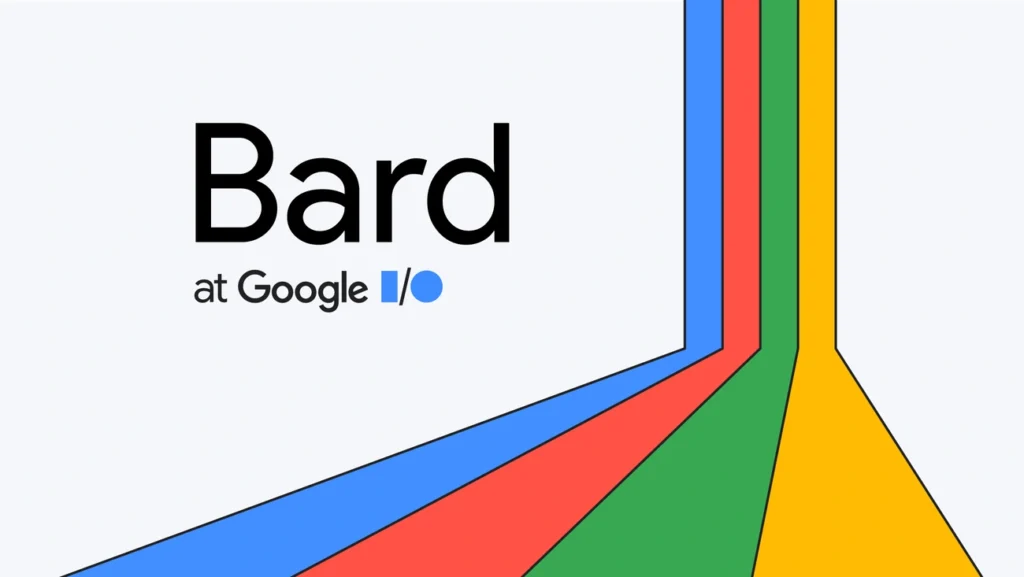
Image Source: The Keyword
12. Bard (Google AI)
Bard evolved into Gemini, which shows off Google’s advanced language model capabilities. The rebranding brings the most important upgrades to its translation functions and overall performance.
Bard key features
- Multimodal inputs let you translate text from images, screenshots, and even flat tire photos when you need help on the go
- Conversational interface understands context from previous prompts to create more natural translations
- Extended language support covers 40+ languages in over 230 countries and territories
- Mobile access through a dedicated Android app and iOS integration via Google app
- Nuanced reasoning capabilities improve translation quality, especially when you have complex content
Bard pros and cons
Pros:
- Direct internet connection provides up-to-date information unlike other competitors
- Multiple translation draft options for each query
- Voice commands and audio responses enable hands-free translation
- Combines smoothly with other Google products like Gmail and Docs
Cons:
- Language capabilities are still developing
- Results between languages can be inconsistent
- Premium features need a subscription
- Specialized terminology can be challenging
Bard pricing
The basic version of Bard is free. Advanced features come with Google One AI Premium Plan at $19.99 monthly. This subscription gives you access to Ultra 1.0, Google’s most capable AI model, plus 2TB storage and other Google One benefits.
Bard best use cases
We used Bard mostly for cross-language communication that needs up-to-the-minute information. Its internet connection makes it effective for translating current events or recent terminology. You’ll find it helpful to explain complex topics in multiple languages or create culturally appropriate content for international audiences.
13. TextUnited
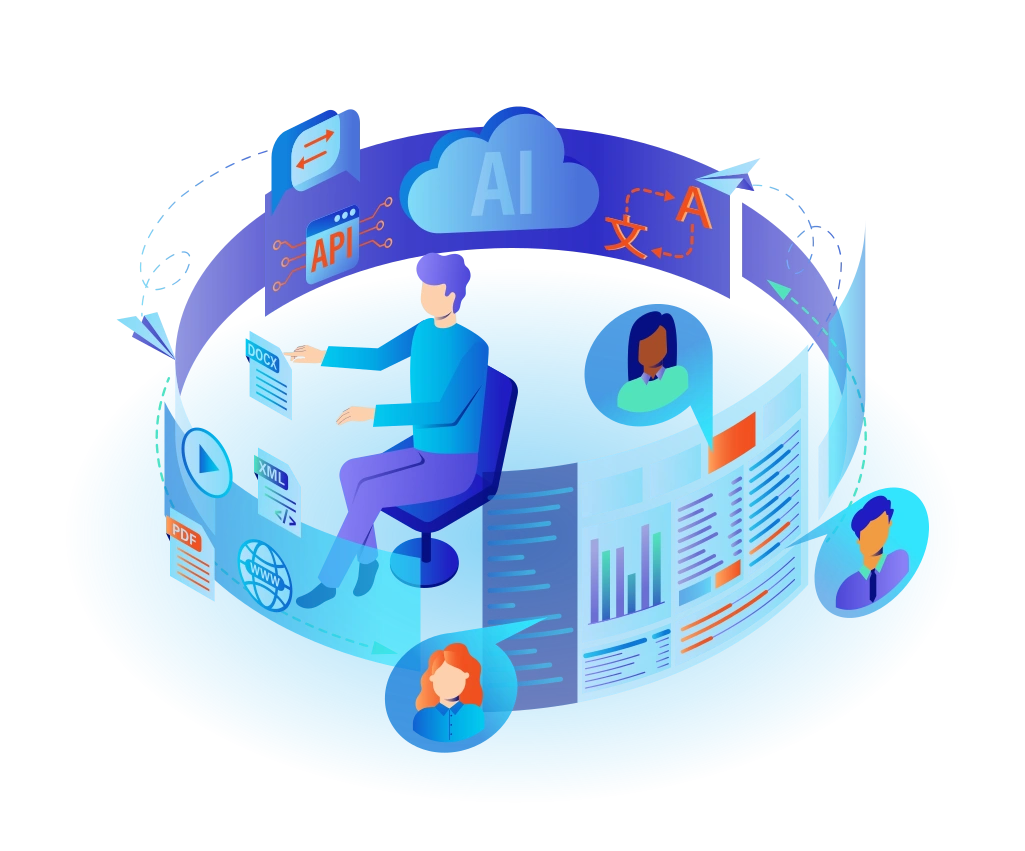
Image Source: TextUnited
13. TextUnited
TextUnited blends AI translation with human oversight to produce high-quality content in multiple languages. The platform coordinates automated workflows while you retain control through human expertise.
TextUnited key features
- Translation memory system that automatically captures and reuses translations
- Built-in CAT tool integrated directly into the platform without requiring third-party tools
- Fine-tuning loop that refines translations by sending machine-translated content through translator review
- Terminology management to keep brand voice consistent across languages
- WordPress plugin that localizes websites without coding knowledge
TextUnited pros and cons
Pros:
- The core team can access a centralized terminology database
- Live collaboration tools help remote teams work better
- Automated quality assurance process
- Data security with SOC2-certified cloud infrastructure
Cons:
- The original learning curve takes time for teams to adapt
- Custom pricing makes comparing costs difficult
- Teams need training sessions to use all features
- System maintenance can affect platform availability
TextUnited pricing
TextUnited creates custom plans based on specific needs. The OnePlatform solution works well for medium to large teams that need detailed translation management. You can get pricing details by asking.
TextUnited best use cases
TextUnited shines in website localization, as 75% of consumers in non-English speaking countries prefer content in their native language. The platform works great for software localization projects that use XLIFF format. Companies can reach international customers without coding knowledge.
14. DeepSeek
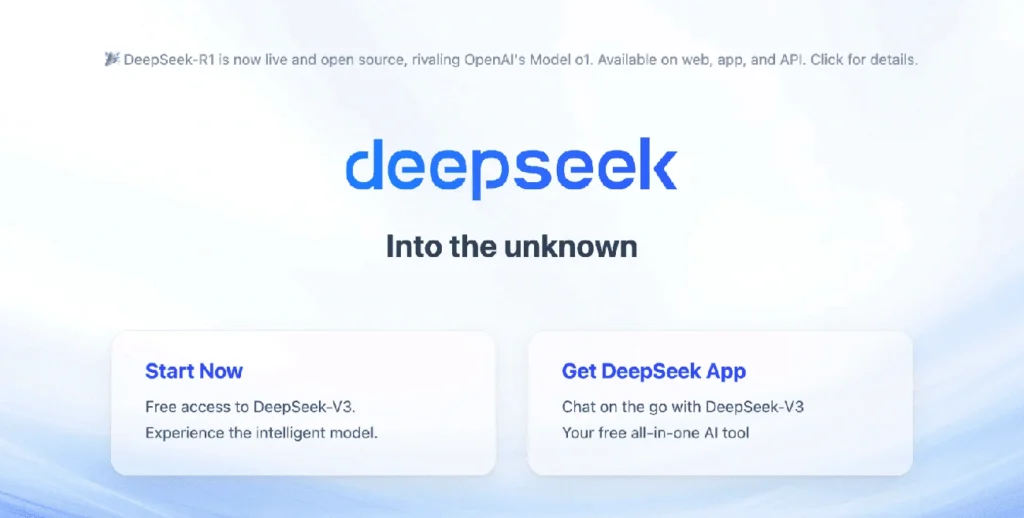
Image Source: Lark
14. DeepSeek
DeepSeek launched in Hangzhou, China and quickly became a notable AI translator in early 2025. This open-source solution delivers results that match OpenAI’s models but costs much less to operate.
DeepSeek key features
- Superior Chinese translation capabilities that excel in Chinese-to-English conversions
- Mixture of Experts (MoE) technology lets different model components handle specific tasks
- Resource efficiency in both training and inference stages
- Technical language that maintains sentence structure and consistent terminology
- Open-source availability with code you can find on GitHub
DeepSeek pros and cons
Pros:
- Delivers exceptional results for Asian and non-Latin script languages like Chinese, Korean, and Japanese
- Costs 50 times less than Google Translate
- Technical documents need 15-30% less editing
- Blends with popular AI platforms like Amazon SageMaker and Azure AI
Cons:
- We focused on fewer language pairs compared to competitors
- Translations stay closer to source text—not ideal for creative content
- Data privacy concerns attract regulatory attention
- Output consistency comes at the cost of speed
DeepSeek pricing
The platform uses token-based pricing with standard and discount options. Deepseek-chat input tokens cost $0.07 per million (cache hit) or $0.56 per million (cache miss). Output tokens are available at $1.68 per million.
DeepSeek best use cases
Technical, legal, and regulated industries that need accuracy over style will benefit most from DeepSeek. Companies handling large-scale localization projects find great value in this tool. Chinese language excellence makes it perfect for businesses that need reliable Chinese translations in their workflow.
15. Canva Translate

Image Source: Canva
15. Canva Translate
Canva’s AI translator helps you create multilingual content right inside your design workspace. The tool blends into your workflow and makes reaching global audiences simple.
Canva Translate key features
- 130+ language support for translating presentations, social media posts, and more
- Tone of voice selection currently available in select languages
- Format preservation that maintains your design’s layout even when switching between LTR and RTL languages
- Translation settings including font size reduction, page duplication, and layout mirroring options
- One-click workflow letting you translate entire pages or specific text elements
Canva Translate pros and cons
Pros:
- You won’t need separate translation tools
- Your original design elements and formatting stay intact
- The tool fits right into Canva’s accessible interface
- Works with all Canva designs
Cons:
- Free users can only translate 50 pages
- Simple and short sentences work best
- Some fonts don’t support translation
- You need a Pro subscription to access everything
Canva Translate pricing
The tool starts with a free trial for one translation. Free users can translate up to 50 pages during their membership. Pro and Teams users get 500 pages of translation each month per user. The feature comes with Canva Pro, Teams, Nonprofit, and Education subscriptions.
Canva Translate best use cases
This AI translator serves franchisees who need quick localization of marketing materials. On top of that, it works great for multilingual social media campaigns. Small businesses can create professional global content without language expertise.
16. QuillBot Translator

Image Source: QuillBot
16. QuillBot Translator
QuillBot Translator helps you overcome language barriers at no cost. This AI translator supports 52 languages and dialects, making it the quickest way to translate text.
QuillBot Translator key features
- Context-aware translations that maintain the original text’s tone and style
- Support for 52 languages with new additions that keep coming
- Transliteration capability for Chinese and Hindi into Latin alphabet
- Synonym options for English, Spanish, French, German, and Portuguese
- Integration with other QuillBot tools like Grammar Checker and Paraphraser
QuillBot Translator pros and cons
Pros:
- Free to use without any ads
- Generous 5,000 character limit per translation that exceeds Google Translate
- You can start using it right away without signing up
- User-friendly mobile interface
Cons:
- Free version stops at 5,000 characters
- Paraphraser tool works with just 26 languages
- Grammar Checker supports only 6 languages
- You need premium for unlimited character translations
QuillBot Translator pricing
- Free: 5,000 characters per translation with unlimited translations
- Premium: No character limits plus extra features like transliteration and synonyms
QuillBot Translator best use cases
QuillBot shines when you need to translate emails, academic articles, menus, travel guides and website content. Students find it helpful when reading foreign language research materials. Travelers depend on it to chat with locals during their trips abroad.
Comparison Table
| AI Translator | Languages Supported | Starting Price | Key Distinctive Feature | Best For | Notable Pro | Notable Con |
|---|---|---|---|---|---|---|
| DeepL | European languages focus | $8.99/month | 82% market adoption by language service companies | Business communication | 1.3x more accurate than Google | Limited language options |
| Google Translate | 130+ | Free | Live conversation translation | Everyday travel communication | High accuracy (94%) for Spanish | Varies by language pair |
| ChatGPT | 80+ | Free (GPT-3.5) | Understands context | Internal communications | 88.7% accuracy on measures | Quality varies by language |
| Lokalise AI | 30+ | $120/month | Multi-engine technology | Quick product launches | 10x faster than traditional methods | Needs TMS subscription |
| Microsoft Translator | 90+ | Free tier (2M chars) | Neural machine translation | Enterprise integration | Smooth Microsoft integration | Complex API setup |
| Amazon Translate | 75 | $15/M chars | Processes in batches and instantly | AWS ecosystem projects | Scales well | Made for developers |
| Smartling | Not mentioned | Custom | Visual context tools | Multi-platform content | 50% cost reduction | Takes time to learn |
| Unbabel | Not mentioned | $30,000/year | Combined AI-human translation | Global customer support | Human-verified quality | Expensive |
| Wordly | Multiple pairs | Usage-based | Translates events instantly | Live events | Quick 5-minute setup | Needs internet |
| TranslatePress AI | Not mentioned | €99/year | WordPress integration | WordPress websites | Easy to integrate | Works only with WordPress |
| Copy.ai | 30+ | $49/month | Brand Voice feature | Marketing content | Marketing-focused | Sometimes inaccurate |
| Bard (Gemini) | 40+ | $19.99/month | Handles multiple input types | Instant communication | Internet connected | Results vary |
| TextUnited | Not mentioned | Custom | Translation memory system | Website localization | Central terminology | Steep learning curve |
| DeepSeek | Focus on Asian languages | $0.07/M tokens | Excellence in Chinese | Technical translation | Cost-effective | Limited language pairs |
| Canva Translate | 130+ | Free trial | Integrates with design | Marketing materials | Keeps formatting | 50-page free limit |
| QuillBot Translator | 52 | Free | Smart context translation | Quick translations | No advertisements | 5,000 character limit |
17. Pairaphrase
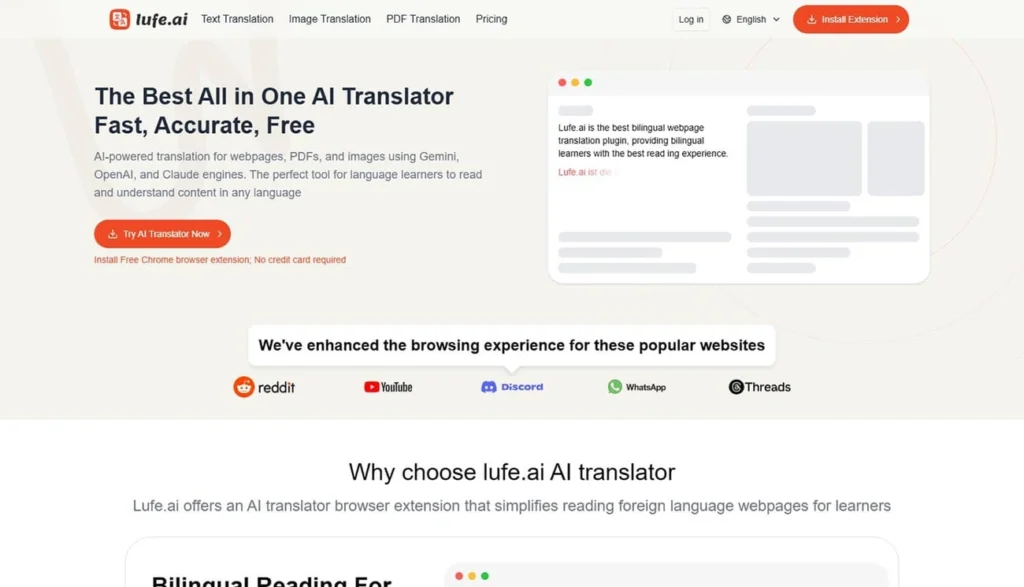
Your specific communication needs will determine the best AI translator for you. Each tool brings something special to the table. DeepL shines with business documents, while Google Translate is a better match for quick travel translations. ChatGPT’s grasp of context makes it perfect for conversational content.
Language requirements should be your first priority when picking a translation tool. The cost factor matters too, with options ranging from free tools to enterprise packages that cost thousands each year. You might also need special features like keeping document formats intact or support for industry terms.
Our comparison table shows what each translator does best and where it falls short. The list includes options that work for simple travel help or full-scale translation management. Note that the most sophisticated AI translators still need human eyes for important messages.
AI translation keeps getting better and breaks down language barriers faster than ever before. People can now share ideas across languages with amazing precision and speed. The right tool from our detailed list will make global communication both available and cost-effective.
Conclusion
Image Source: CPO Magazine
AI translation technology advances faster each day, but human translators remain essential. The translation market grows as people translate more content than ever before.
AI translators deliver amazing speed and cost benefits to global communication. Human translators provide cultural nuance and emotional intelligence that machines can’t match. This creates a partnership rather than competition between the two.
Businesses expanding globally need both AI efficiency and human expertise. Translators who work with AI will succeed by leveraging their unique human abilities: analytical thinking, cultural awareness, and interpersonal skills.
Want your business to reach global audiences? 🌍 At Mehnav, we create websites and SEO strategies that make you visible everywhere—no translation needed. Let’s grow your brand worldwide. 👉 mehnav.com
Smart professionals see AI translators as valuable tools that handle routine work while they focus on more important tasks. Mehnav helps businesses direct their path in the digital world by creating multilingual-ready websites.
Success comes to those who combine AI’s efficiency with human creativity. Mehnav understands this delicate balance and helps you communicate clearly across borders without losing meaning in translation.
Key Takeaways
Here are the essential insights from our comprehensive analysis of the 17 best AI translator tools for 2025:
• DeepL leads accuracy with 82% market adoption – Delivers 1.3x better translations than Google, making it ideal for business communications requiring precision.
• Choose tools based on specific needs – Google Translate excels for travel, ChatGPT for context-aware content, while enterprise solutions like Smartling reduce costs by 50%.
• AI translation costs have dropped dramatically – DeepSeek offers 50x cost reduction compared to traditional methods, with many tools providing free tiers for basic usage.
• Hybrid AI-human approaches deliver best results – Tools like Unbabel combine machine speed with human oversight, achieving 22.5% CSAT improvements for global support teams.
• Integration capabilities matter most for businesses – Platforms offering seamless workflow integration (Lokalise AI, Microsoft Translator) accelerate translation processes by 10x while maintaining quality.
The translation landscape has evolved from basic word-for-word conversion to sophisticated, context-aware systems. Success lies in matching the right tool to your specific use case—whether that’s quick travel communication, enterprise document translation, or real-time event interpretation. The future belongs to those who strategically combine AI efficiency with human expertise for optimal results.
FAQs
Q1. What is currently considered the best AI translator tool? DeepL is widely regarded as one of the top AI translators in 2025, with 82% adoption by language service companies. It offers superior accuracy, especially for European languages, and is 1.3 times more accurate than Google Translate for business communications.
Q2. How do AI translators compare to human translators? AI translators offer speed and cost efficiency, while human translators provide cultural nuance and emotional intelligence. The future of translation lies in combining AI efficiency with human expertise, especially for businesses expanding internationally.
Q3. Are there free AI translation tools that are reliable? Yes, several reliable free AI translation tools exist. Google Translate offers a comprehensive free service for everyday use. QuillBot Translator provides free context-aware translations for up to 5,000 characters. Many other tools offer free tiers with limited functionality.
Q4. Which AI translator is best for technical or specialized content? DeepSeek excels in technical translations, particularly for Asian languages like Chinese. It offers superior accuracy for technical documents and can reduce translation costs significantly compared to traditional methods.
Q5. How can businesses choose the right AI translator for their needs? Businesses should consider factors such as language pairs needed, budget constraints, integration capabilities, and specific features like document formatting preservation. Tools like Lokalise AI and Smartling offer comprehensive solutions for businesses managing multilingual content across multiple platforms.

